Statewide Communication Interoperability Plan (SCIP) Implementation Report
Statewide Communication Interoperability Plan (SCIP)
5_NECP Capabilities Assessment Guide_07072010_FINAL READY FOR PRINT_FINAL_2010-09-03
Statewide Communication Interoperability Plan (SCIP) Implementation Report
OMB: 1670-0017
Introduction
As the first national strategic plan to improve interagency communications among public safety agencies in the United States, the National Emergency Communications Plan (NECP) establishes three performance Goals and a range of capabilities for emergency responders to build upon.1 The Department of Homeland Security (DHS) Office of Emergency Communications (OEC) will assess the Nation’s progress in meeting these outcome-oriented Goals by conducting evaluations of planned events for NECP Goal 12 and evaluations of incidents, exercises, and planned events for NECP Goal 23. In order to assess more broadly communications interoperability, it will also request that State, local, and tribal governments assess and report on their capabilities to attain and maintain interoperability across the five dimensions of the SAFECOM Interoperability Continuum4.
Guide Synopsis
This document is intended to provide practical guidance for assessing interoperable communications capabilities and will be particularly useful during NECP implementation efforts in 2010 and 2011. The primary audience is Statewide Interoperability Coordinators (SWICs) responsible for implementing their Statewide Communication Interoperability Plans (SCIPs), as well as Urban Area Working Groups (UAWG), and tribal representatives. Capability assessments can identify challenges and successes and help you build effective strategies for achieving and sustaining interoperability.
The following sections provide background on capabilities assessments, key terms, and definitions. It also covers the actual questions used to identify stages of development, methods for collecting data, and means of reporting results. Use the section on “data collection methods” to develop your own assessment process for carrying out NECP Goal 1 assessments of UASI regions and describe the methodology that will be used for Goal 2 assessments in 2011.
Because this assessment effort is a nationwide process, anticipate that officials in your State, region, or county will be interested in the assessment process and results. This guide may be useful in producing similar reports independently for them and governing bodies in the future.
I. Background
The National Emergency Communications Plan
The NECP establishes a vision for future communications interoperability. Its three Goals target the Nation’s ability to assure response-level emergency communications5, first during routine operations and, ultimately, during significant incidents as outlined in national planning scenarios6. It further encourages the development of a range of capabilities and establishes seven objectives to broadly improve emergency communications in the areas of decision-making structures and leadership roles; use of common planning and operational protocols; use of standards-based technology; and shared approaches to training and exercises.
NECP capabilities and objectives grew from the SAFECOM
Interoperability Continuum (pictured below), first developed in 2004
with the emergency response community. The Continuum has provided
the basis for further definition of capabilities and metrics in the
areas of Governance, Standard Operating Procedures (SOPs),
Technology, Training and Exercises, and F
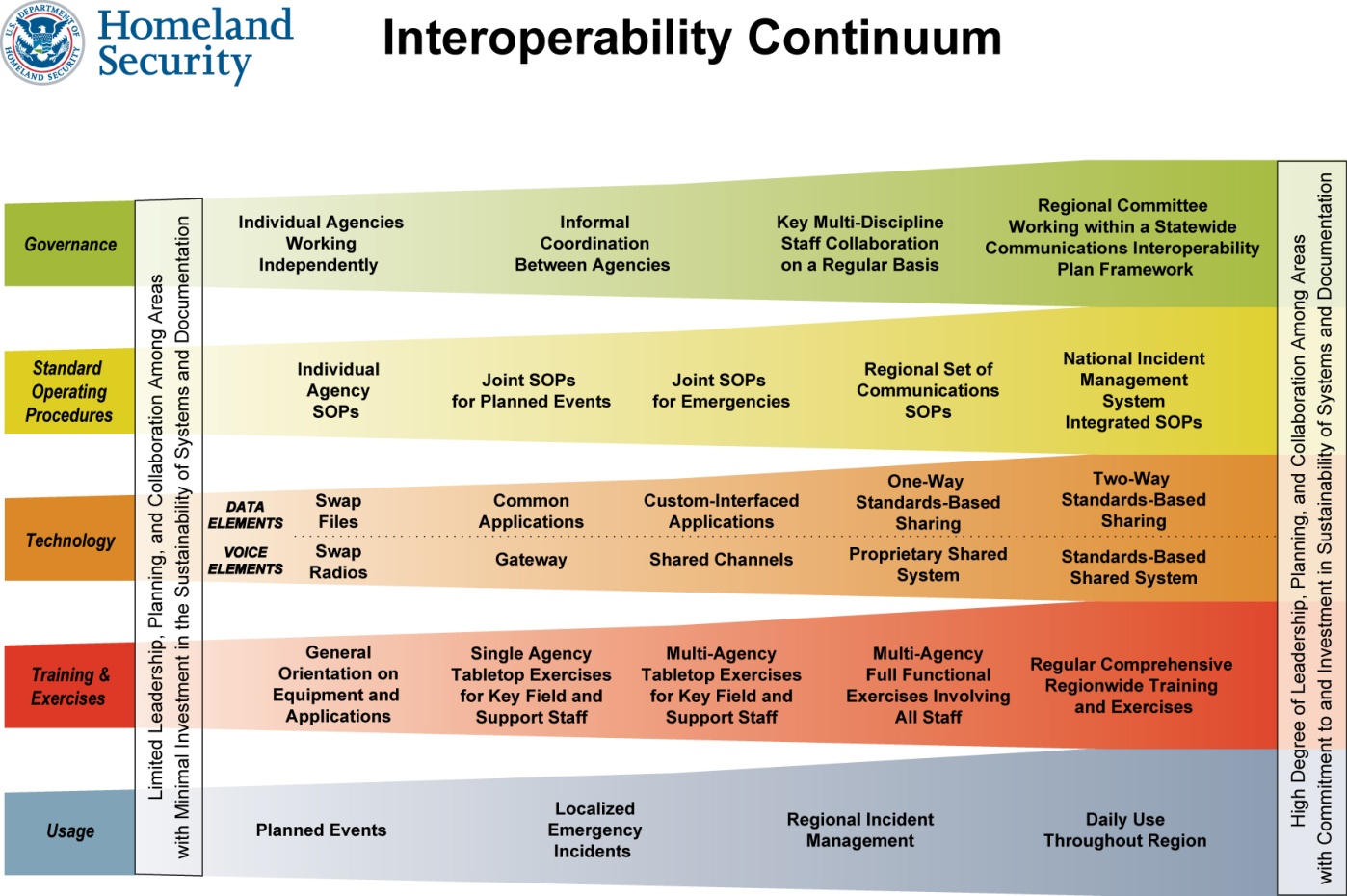 requency
of Use. Similar stages of development were also used in the 2006
evaluation of UASI tactical communications capabilities and the
National Baseline Survey released later that year. Most recently,
the capability measures were at the heart of the National
Communications Capability Report produced in 2008.
requency
of Use. Similar stages of development were also used in the 2006
evaluation of UASI tactical communications capabilities and the
National Baseline Survey released later that year. Most recently,
the capability measures were at the heart of the National
Communications Capability Report produced in 2008.
For the purpose of evaluating progress in implementing the NECP, capabilities will be assessed along the dimensions of the Continuum. A more detailed description of the NECP capabilities assessment and a tool to assist in this assessment are provided in Section 3, “Capabilities Assessment Questions and Decision Trees.”
NECP Goal 1 & 2 Assessment
NECP Goals 1 and 2 target the routine communications interoperability of UASI and non-UASI jurisdictions, respectively. Evaluations of progress in meeting both will combine assessments of capabilities with those of actual performance.
Capabilities data will be collected through the assistance and guidance of SWICs with the support of Statewide Interoperability Governance Bodies (SIGBs) and intrastate Regional Interoperability Governance Bodies at UASI regional (Goal 1) and countywide or countywide-equivalent (Goal 2) levels.
Performance data can also be coordinated by the SWIC, SIGB, intrastate Regional Interoperability Governance Bodies, and UASI governance bodies. For Goal 1, OEC teams of peers and subject matter experts will observe response-level emergency communications during planned events, such as large sporting events and public gatherings. For Goal 2, jurisdictions across counties and/or similar geographic subdivisions will be asked to assess their individual performance using a self-evaluation tool.
Progress in meeting the NECP Goals will be reported through annual SCIP Implementation Reports required of recipients of Interoperable Emergency Communications Grant Program (IECGP) funding. Federal Fiscal Year 2010 Implementation Reports will include capability assessment results for each UASI region within the State. They will also describe the methodology that will be used for countywide assessments in 2011. Fiscal Year 2011 SCIP Implementation Reports will include the results of those Goal 2 assessments and a capability assessment for each county in the State.
II. Key Terms & Definitions
For the purposes of the NECP Goals and their associated capabilities assessments, key terms and definitions are provided below.
Area
As used here, a UASI region, tribal community, county, or county geographic equivalent.
Capabilities Assessment
The assessment of the highest levels of interoperable communications capabilities, as defined in this document, within a UASI region, county, or tribal community to evaluate progress in meeting Goals 1 and 2 of the National Emergency Communications Plan.
NECP Goals Evaluations
Assessments of progress in meeting national goals for communications interoperability established in the National Emergency Communications Plan. Goals 1 and 2 will be evaluated through a two-part process involving assessment of capabilities and actual performance.
Non-UASI Jurisdictions
All counties or equivalents. Note: This includes the counties within the sixty urban areas defined by the FY 2008 UASI Program7, however capability information should be assessed for the individual county and not the UASI task force as a whole (which will be reported through Goal 1).
SCIP
Statewide Communication Interoperability Plan. A strategic plan that identifies near- and long-term initiatives for improving communications interoperability within a State.
SWIC
Statewide Interoperability Coordinator. The individual designated in a State as the single point of contact responsible for managing the SCIP and its implementation.
Tribal Communities
Native American Indian entities recognized by, and eligible to receive services from, the United States Bureau of Indian Affairs.8
Urban Area Security Initiative Jurisdictions
For purposes of NECP Goal 1, UASI jurisdictions are the 60 high-risk urban areas designated by the Department of Homeland Security for FY 2008.
III. Capabilities Assessment Questions and Decision Trees
The following section provides a tool for evaluating interoperable communications capabilities for NECP assessment purposes. Lanes of the Interoperability Continuum are shown with statements describing various stages of capabilities development ranging from Early through Advanced. Each lane is accompanied by a decision tree with key questions that differentiate stages of development. The first question is used to distinguish Early and Intermediate stages from Established and Advanced stages of development. Depending on your answer to the first question, you will then answer a subsequent question to either distinguish Early from Intermediate stages or Established from Advanced stages.
When assessing capabilities, please be as truthful as possible. Respondents should not feel pressured to identify an Advanced stage of development for each lane of the Continuum. An honest assessment will ensure that time and resources are appropriately dedicated to the interoperable communications effort. Furthermore, each area has its own unique capability requirements and needs. These requirements and needs—based on factors such as population density, geographical landscape, and location relative to bordering areas—determine the appropriate level of capability for an area. For instance, it may be determined that an Established stage of development is appropriate for a UASI whereas an Intermediate stage of development is equally appropriate for a non-UASI area in the same State.
Capability assessment data will be collected by SWICs in their SCIP Implementation Reports. When reporting this data, SWICs are encouraged to provide a narrative that justifies the current stage of capability development in each of their State’s areas. This written justification will afford SWICs the opportunity to affirm that their State’s stages of capability development are appropriate given the requirements and needs of their areas.

What are we measuring: The formality of and level of participation in interagency partnerships, forums, or governing bodies established to address common interoperability interests in the area.
Capability |
Early Implementation |
Intermediate Implementation |
Established Implementation |
Advanced Implementation |
Governance |
Area decision-making groups are informal and do not yet have a strategic plan to guide collective communications interoperability goals and funding. |
Some formal agreements exist and informal agreements are in practice among members of the decision making group for the area; Strategic and budget planning processes are beginning to be put in place. |
Formal agreements outline the roles and responsibilities of an area-wide decision making group, which has an agreed upon strategic plan that addresses sustainable funding for collective, regional interoperable communications needs. |
Area-wide decision making bodies proactively look to expand membership to ensure representation from broad public support disciplines and other levels of government, while updating their agreements and strategic plan on a regular basis. |
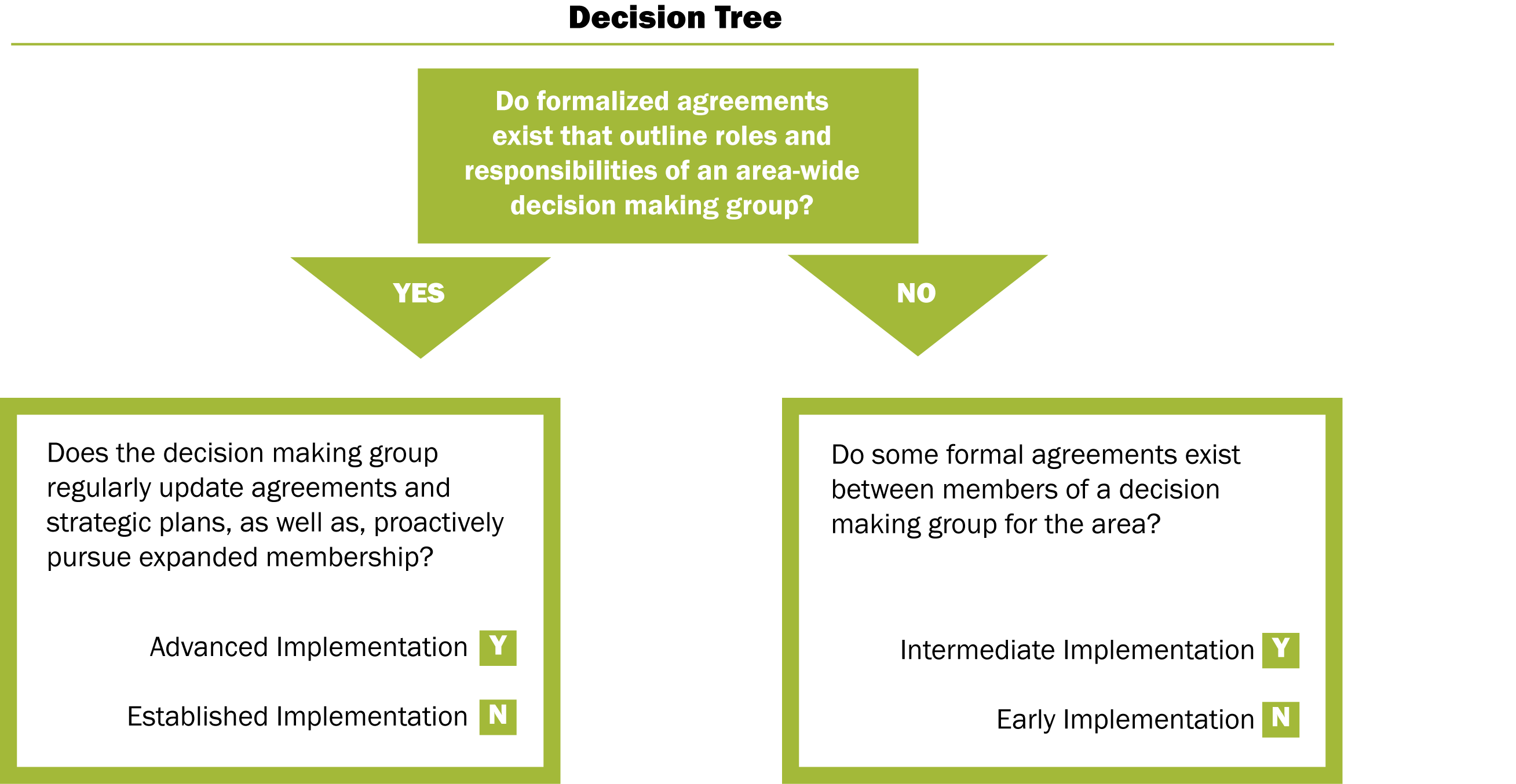


What are we measuring: The level of adequacy, participation in developing, and consistency of formalized SOPs to address common interoperability interests in the area.
Capability |
Early Implementation |
Intermediate Implementation |
Established Implementation |
Advanced Implementation |
SOPs |
Area-wide interoperable communications SOPs are not developed or have not been formalized and disseminated. |
Some interoperable communications SOPs exist within the area and steps have been taken to institute these interoperability procedures among some agencies. |
Interoperable communications SOPs are formalized and in use by all agencies within the area. Despite minor issues, SOPs are successfully used during responses and/or exercises. |
Interoperable communications SOPs within the area are formalized and regularly reviewed. Additionally, NIMS procedures are well established among all agencies and disciplines. All needed procedures are effectively utilized during responses and/or exercises. |
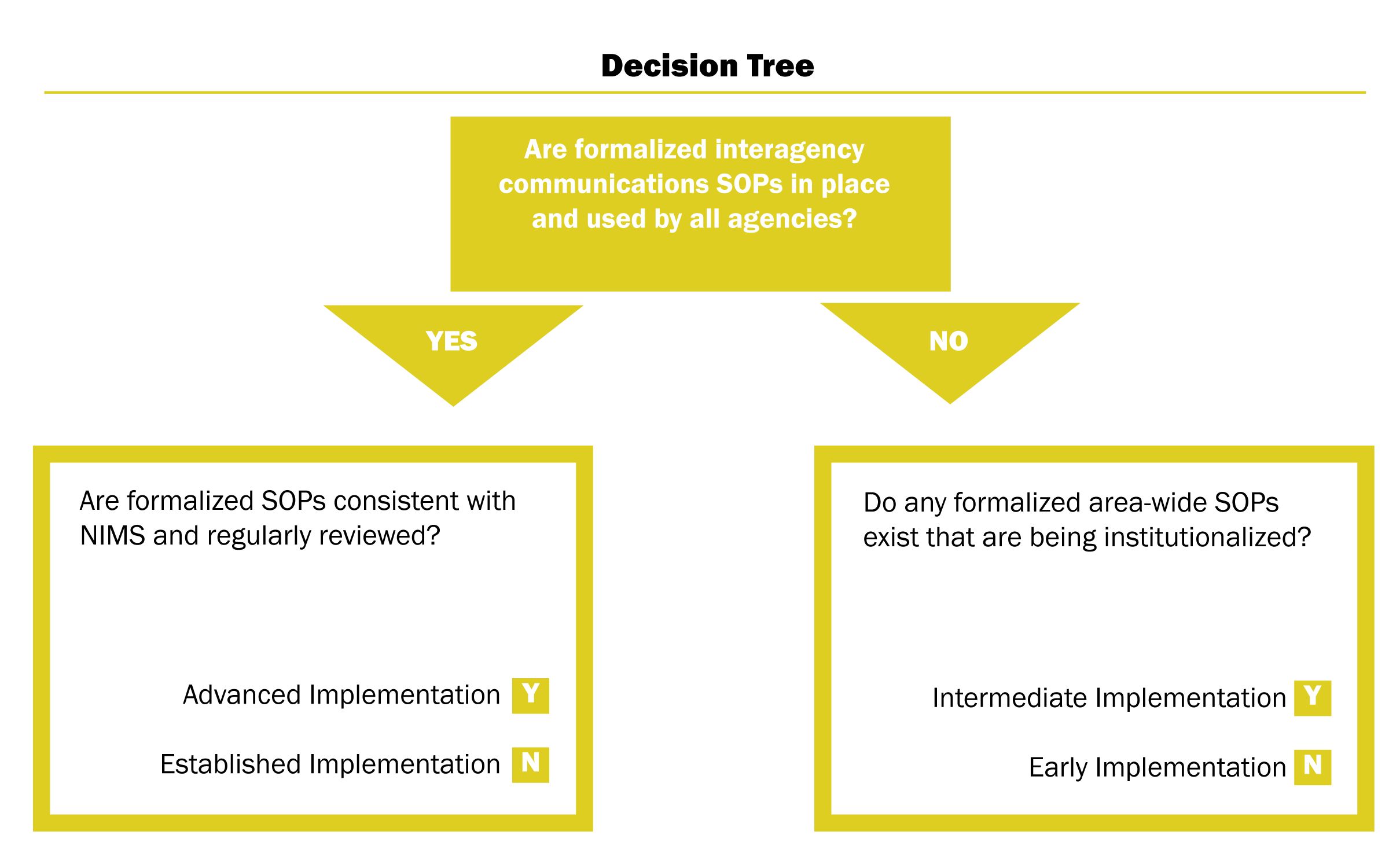

`

What are we measuring: The technology standards and equipment that are being utilized to effectively provide interagency communications in the area.
Capability |
Radio Cache/ Gateways |
Shared Channels |
Shared System |
Standards-Based Shared System |
Technology |
Interoperability within the area is primarily achieved through the use of gateways (mobile/fixed gateway, console patch), shared radios, or use of a radio cache. |
Interoperability within the area is primarily achieved through the use of shared channels or talk groups. |
Interoperability within the area is primarily achieved through the use of a proprietary shared system. |
Interoperability within the area is primarily achieved through the use of standards-based shared system (e.g., Project 25). |
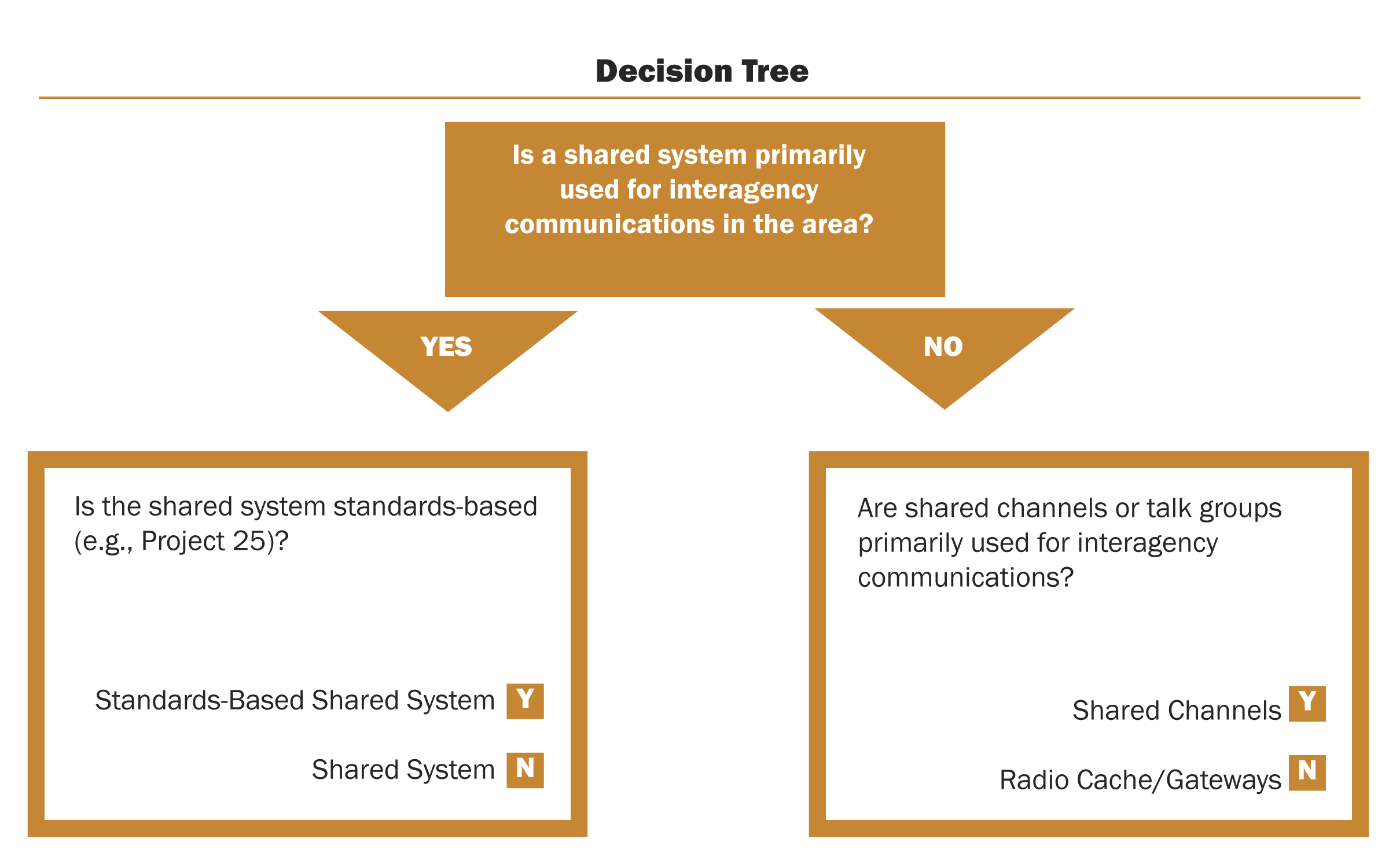


What are we measuring: The availability and regularity of training and exercise programs for communications interoperability.
Capability |
Early Implementation |
Intermediate Implementation |
Established Implementation |
Advanced Implementation |
Training & Exercises |
Area-wide public safety agencies participate in communications interoperability workshops, but no formal training or exercises are focused on emergency communications. |
Some public safety agencies within the area hold communications interoperability training on equipment and conduct exercises, although not on a regular cycle. |
Public safety agencies within the area participate in equipment and SOP training for communications interoperability and hold exercises on a regular schedule. |
Area public safety agencies regularly conduct training and exercises with communications interoperability curriculum addressing equipment and SOPs that is modified as needed to address the changing operational environment. |



What are we measuring: Ease and regularity of using interagency communications technologies and procedures within the area and across all types of events, including day-to-day, task force, and mutual aid operations.
Capability |
Early |
Intermediate |
Established |
Advanced |
Usage |
First responders across the area seldom use solutions unless advanced planning is possible (e.g., special events). |
First responders across the area use interoperability solutions regularly for emergency events, and in limited fashion for day-to-day communications. |
First responders across the area use interoperability solutions regularly and easily for all day-to-day, task force, and mutual aid events. |
Regular use of solutions for all day-to-day and out-of-the-ordinary events across the area on demand, in real time, when needed, as authorized. |


IV. Data Collection Methods
Generally, capabilities assessments for both Goal 1 in 2010 and Goal 2 in 2011 are nearly identical—varying only in scope. Both use the same stages of development to assess capabilities across lanes of the Continuum. The difference lies in the number of capability assessments that must be carried out and reported to evaluate attainment of the NECP Goals. Goal 1 requires capabilities assessments of the 60 defined UASI regions whereas Goal 2 requires assessments of all non-UASI jurisdictions (i.e., counties, parishes, or county-equivalents) inclusive of the individual counties within UASI areas.
Who Assesses Capabilities?
Many different people may be involved in conducting the Goal 1 and 2 capabilities assessments. The SWIC or SCIP point of contact is foremost responsible for annual SCIP Implementation Reports to OEC which, for 2010 and 2011, will include performance and capabilities assessments of, respectively, UASI and non-UASI jurisdictions. SWICs may choose to take a more or less active role in actually carrying out assessments. OEC anticipates most will ask responsible regional and local officials to carry out self-assessments. These results will then be communicated back to the SWIC, who will compile the results into the State’s SCIP Implementation Report. In this case, the SWIC assumes a coordinating, quality control, and reporting role.
Actual assessments may involve multiple people at the regional, tribal, or county levels. By their very existence, UASI regions (Goal 1) have multi-jurisdictional governance bodies (working groups). The Urban Area Working Group (UAWG) chair is broadly responsible for capabilities assessments—communications or otherwise—but may delegate the duty to an individual or committee. The UAWG chair and person(s) carrying out the assessment must recognize that, for Goal 1, a simple assessment is sought for the region as a whole, including all jurisdictions.
Goal 2 capabilities assessments of non-UASI jurisdictions may be carried out for a single county or for a group of counties located within the same intrastate region. In the former case, it is recommended that an official accountable for emergency services countywide—not just a county government spokesman—should carry out the assessment, recognizing that the task may be delegated to another individual or committee. In the latter case, the chair of the regional governance body should be given primary responsibility for carrying out assessments for each county. Once again, this task may be delegated but a single individual or committee accountable to all counties involved should have the primary responsibility.
Identifying and Preparing Assessors
OEC anticipates that actual assessments will be carried out most often by regional and countywide communications coordinating bodies. However, it recommends giving the homeland security or emergency management official responsible for the area primary responsibility for assessments to assure accountability for the often sensitive issue of communications interoperability.
Regardless of who actually conducts the assessment that individual will need some background on the process, instructions for completing forms, and a deadline for submitting the results. SWICs or other SCIP points of contact should prepare those who will complete the assessments by providing this document with a cover letter explaining the purpose and approach adopted statewide. Also provide a deadline for submission of completed assessments and contact information for questions.
Consider holding an open conference call or online meeting for interested parties where the purpose and approach can be presented more interactively and questions can be addressed. If a call or online meeting is to be held, announce the fact and provide instructions for joining in your initial cover letter to minimize the number of follow-up questions and assure a common answer is provided to each.
The capability assessments are organized according to the five lanes of the Interoperability Continuum, with two questions corresponding to each lane. Completion of the capability assessment should be rudimentary for persons knowledgeable of capabilities in the area.
Goal 1 Capabilities Assessments
C apabilities
will be assessed for a total of 60 UASI regions9
as part of the Goal 1 evaluation in 2010. Even the most populous
States will only have a few to conduct.10
Capability assessments must be conducted by individuals familiar
with, and accountable to, the region. To begin the process, SWICs
and SCIP points of contact in States with UASI regions should:
apabilities
will be assessed for a total of 60 UASI regions9
as part of the Goal 1 evaluation in 2010. Even the most populous
States will only have a few to conduct.10
Capability assessments must be conducted by individuals familiar
with, and accountable to, the region. To begin the process, SWICs
and SCIP points of contact in States with UASI regions should:
Establish their own overall schedule based on when responses are needed for inclusion in the SCIP Implementation Report.
Formally notify the chair of each UAWG of the necessity of completing the assessment.
Provide an estimate that it will take a knowledgeable person or group one hour or less to complete.
Suggest that the appropriate person will be both knowledgeable of regional capabilities across all lanes of the Continuum and able to provide an authoritative response on behalf of the UASI region.
Acknowledge that the UAWG may choose to complete the assessment as a group or have a communications committee do so, but ask that a single individual be identified as a point of contact (POC) and assigned responsibility for completion.
Provide the identified POC this guide for background on the assessment process. Section III, above, may be printed out and completed by hand by the regional representative. Explain to that person that responses must be representative of the entire region. Communicate once again the deadline for receipt of the assessment. Around a month before the deadline, follow-up to remind of the need to complete the assessment. Providing a reminder a month in advance allows enough time for a group to meet if a group, rather than an individual, is doing the assessment.
Upon receipt of the UASI region assessments, review for completeness and consistency with your knowledge of their capabilities. Provide the POC an opportunity to respond to or reconsider a conclusion if you feel the region has been too critical or generous in its assessment.
The results should be included in your 2010 SCIP Implementation Report. Section V of this guide suggests means of representing the results.
Preparing Your Goal 2 Methodology
Y our
2010 SCIP Implementation Report should include a description of the
methodology that will be used statewide to assess all jurisdictions.
our
2010 SCIP Implementation Report should include a description of the
methodology that will be used statewide to assess all jurisdictions.
Statewide Approach
Is it possible for a single individual statewide, perhaps you or someone else in your office, to carry out assessments for all counties outside of UASI regions? This might be an appropriate approach for those States with a small number of counties. While accountability for completion of the project and consistency in results would be higher as a result of choosing this method, some States may deem the statewide approach too large an endeavor for a single person to carry out.
If you choose to conduct the assessments from a State level, consider validating the conclusions by submitting them to identified regional or county officials for review before finalizing. If you do so, include enough time in your schedule for a reasonable review period and resolution of any disputes.
Regional Approach
One alternative to the statewide approach is to have regional bodies lead the data collection efforts by assessing each county in their region. Potential bodies include regional communications, emergency management, or homeland security bodies. In some States, a single individual may be responsible for maintaining regional capability assessments. Others have formal regional working groups, much like UASI regions, which are inclusive of all counties in a State.
A regional approach is much like the Goal 1 (2010) approach with UASI regions described above. A regional chair should designate a single individual as the point of contact (POC) with responsibility for seeing that the assessment is completed, whether by the group or a single individual. The big differences are that collectively the regions must encompass the entire State and that individual assessments for Goal 2 are needed for each county, rather than a summary of the entire region.
Countywide Approach
Some States may choose to conduct Goal 2 assessments by going directly to a county emergency management official or chair of a local emergency planning committee. As with UASI regions and Goal 1, the identified individual would be asked to carry out one assessment that is representative of all jurisdictions and agencies in the county.
The primary challenge with a countywide approach is managing the number of individuals that require coordination and guidance. While the majority will be responsive, the few who are not require considerably more time. This is not uncommon across other homeland security risk and capabilities assessments. Your State administering agency for homeland security grant funds may have useful suggestions on who to work with in each county and how to deal with counties that are less responsive.
If you choose to work individually with counties in your State, anticipate that at least 10% will require repeated follow-up calls, either initially to get a POC or eventually to get the assessment.
Tribal Communities
As the tribal communities are sovereign entities, OEC will collect capability data for these jurisdictions independent of the SCIP Implementation Report process. Therefore, while States are encouraged to integrate tribes into any of the approaches listed above (as appropriate), the actual reporting of this data is not a responsibility of the SWIC.
Goal 2 Capabilities and Performance Assessments
O nce
a State has finalized and submitted its Goal 2 methodology in the
2010 SCIP Implementation Report, and OEC has validated it, States are
encouraged to begin collecting capability data. Executing becomes a
matter of carrying out the plan, maintaining a schedule, tracking
progress, validating responses, and resolving disputes.
nce
a State has finalized and submitted its Goal 2 methodology in the
2010 SCIP Implementation Report, and OEC has validated it, States are
encouraged to begin collecting capability data. Executing becomes a
matter of carrying out the plan, maintaining a schedule, tracking
progress, validating responses, and resolving disputes.
Validation of responses simply requires you to verify whether a county’s completed capability assessment aligns with your knowledge of the county’s capabilities. Disparities between assessment of county capabilities and your knowledge may be simple manual errors, misunderstandings of the questions and content or true differences of opinion. In settling disputes, your own experience in dealing with the county, region, or tribe will be the best guide in how to proceed.
If you are a SWIC or SCIP point of contact, recognize your responsibility to provide all jurisdictions and, ultimately, officials, objective feedback consistently statewide. It is not fair to those officials, their emergency responders, or even the citizens to overestimate capabilities, potentially leading to neglect of their improvement. Conversely, overly critical assessments can lead to scarce resources being dedicated unnecessarily to further improvements.
Your final effort in Goal 2 assessments is representing results in the 2011 Implementation Report. Section V offers ideas on how to do so.
V. Incorporating Results into SCIP Implementation Reports
OEC will provide States with SCIP Implementation Report templates for 2010 and 2011. They will include assessment grids laying out capability statements by lane of the Continuum, as presented in Section III above. For Goal 1, SWICs will have each UASI region within the State fill out one of these grids and include the results in the 2010 report.
The 2011 Implementation Report template (see the sample spreadsheet below) will include a spreadsheet broken down by county or county-equivalent to help assemble results from the Goal 2 assessments. You may find the spreadsheet useful for presenting assessment results to stakeholders and others in a simple, intuitive format. The completed spreadsheet should represent all county data collected from across the State and should be attached to the 2011 SCIP Implementation Report. The collection of this information will help SWICs identify interoperability gaps and successes to plan future strategies and improvement planning.
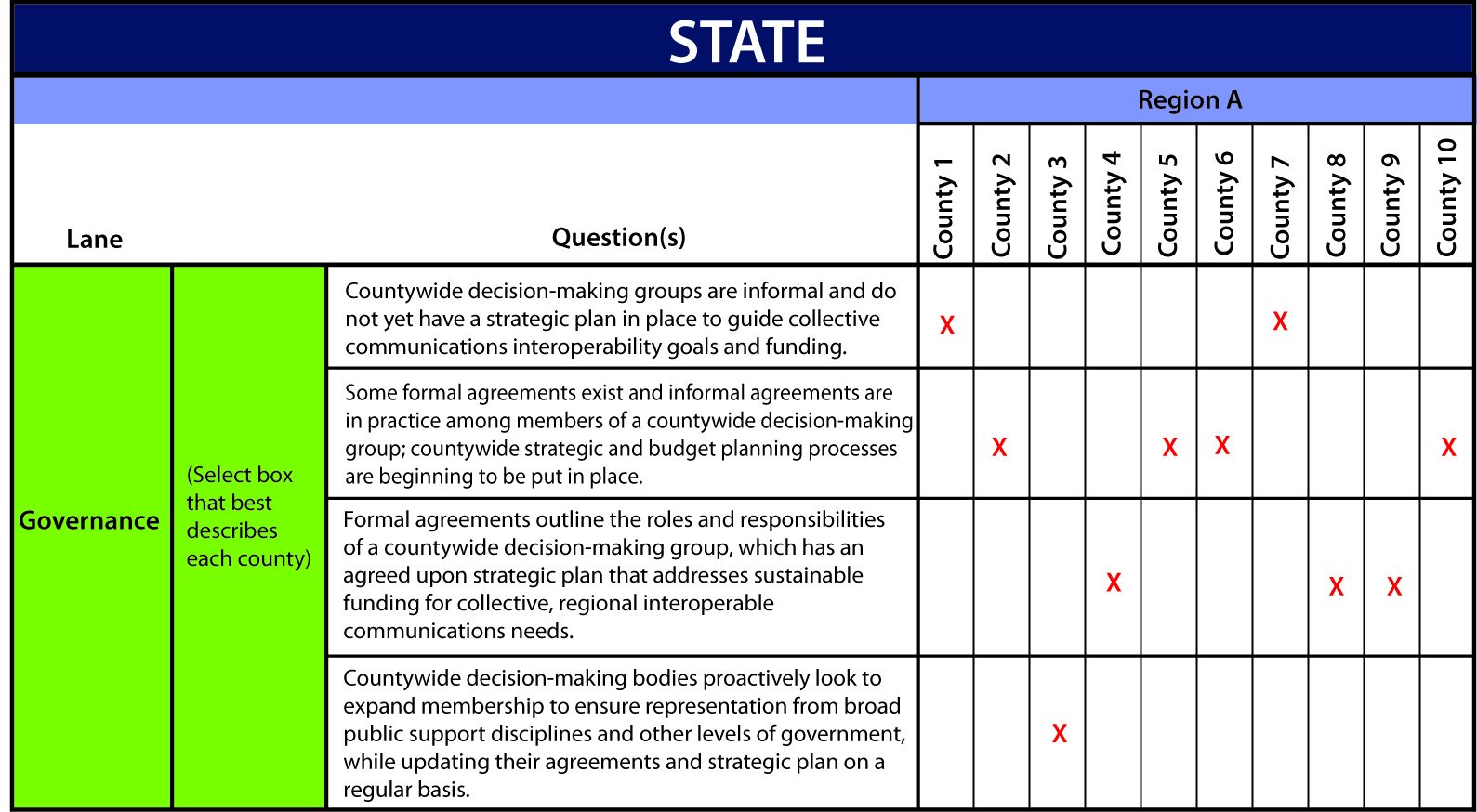
NOTE: In addition to the capability questions addressed in this report, the State reporting spreadsheet will also include additional questions related to technology usage (i.e. frequency bands in use, use of commercial subscriber equipment in responses, etc), as well as recording the results of each county’s response-level communication demonstration as required by the NECP Goals. Additional information and tools related to the response-level demonstration process are available through OEC.
Conclusion
Capabilities assessments will be a sizeable, but necessary, undertaking over the next two years across all levels of government. Nationally, NECP Goals measurement will provide snapshots of emergency interoperable communications capabilities, as well as response-level emergency communications performance. Jointly, the results will help OEC target resources, training, and technical assistance to help bridge the identified gaps. Similarly, this will provide benefits to the States with respect to planning and resource decisions.
The results will be valuable nationwide for these reasons. However, the NECP Goals measurement process may be most valuable in the long-term in creating a basis for ongoing evaluation of a critical aspect of interagency communications, supporting decision-making in a number of areas related to operability, interoperability, and continuity of communications. States, intrastate regions, jurisdictions, tribal nations, and agencies adopting the guidance described in this document now have a uniform and sustainable tool for evaluating key response emergency interoperable communications capabilities.
Appendix A: Sample Capability Factors Data Sheet11
UASI/County/County-Equivalent/Tribal Community Name: _______________
Capability |
Early Implementation |
Intermediate Implementation |
Established Implementation |
Advanced Implementation |
Governance |
A |
S |
F |
A |
SOPs |
Area-wide interoperable
communications SOPs are not developed or have not been formalized
and disseminated. |
S |
Interoperable communications
SOPs are formalized and in use by all agencies within the area.
Despite minor issues, SOPs are successfully used during responses
and/or exercises. |
Interoperable communications
SOPs within the area are formalized and regularly reviewed.
Additionally, NIMS procedures are well established among all
agencies and disciplines. All needed procedures are effectively
utilized during responses and/or exercises. |
Technology |
I |
I |
|
|
Training & Exercises |
A |
S |
P |
A |
Usage |
F |
F |
F |
R |
1 “Emergency Communications Capabilities Needed To Achieve Future State.” National Emergency Communications Plan. July 2008. Page 8.
2 NECP Goal 1 states, “By 2010, 90 percent of all high-risk urban areas designated within the Urban Area Security Initiative (UASI) are able to demonstrate response-level emergency communications within one hour for routine events involving multiple jurisdictions and agencies.” This Goal pertains to UASIs as of July 31, 2008.
3 NECP Goal 2 states, “By 2011, 75 percent of non-UASI jurisdictions are able to demonstrate response-level emergency communications within one hour for routine events involving multiple jurisdictions and agencies.”
4 Information on the SAFECOM Interoperability Continuum can be found online at http://www.safecomprogram.gov/SAFECOM/library/interoperabilitybasics/1190_interoperabilitycontinuum.htm.
5 Response-level emergency communications refers to the capacity of individuals with primary operational leadership responsibility to manage resources and make timely decisions during an incident involving multiple agencies, without technical or procedural communications impediments.
6 Information on the national planning scenarios can be found online at http://www.fema.gov/pdf/media/factsheets/2009/npd_natl_plan_scenario.pdf.
7 For further information on the FY08 UASI Program, see the FEMA grants website: http://www.fema.gov/pdf/government/grant/uasi/fy08_uasi_guidance.pdf.
8 For the official list, see the Library of Congress website: http://www.loc.gov/catdir/cpso/biaind.html.
9 This pertains to the 60 UASI regions identified as of July 31, 2008.
10 The Goal 1 performance assessment is being conducted separately through observations of UASI planned events in 2010.
11 “Area” and “area-wide” serve as generalized terms for the purposes of this document. For NECP Goal 1, “area” represents a UASI region while for NECP Goal 2 “area” represents county or tribal nation.
| File Type | application/msword |
| File Modified | 2010-09-03 |
| File Created | 2010-09-03 |
© 2025 OMB.report | Privacy Policy

 rea
decision-making groups are informal and do not yet have a
strategic plan to guide collective communications interoperability
goals and funding.
rea
decision-making groups are informal and do not yet have a
strategic plan to guide collective communications interoperability
goals and funding.